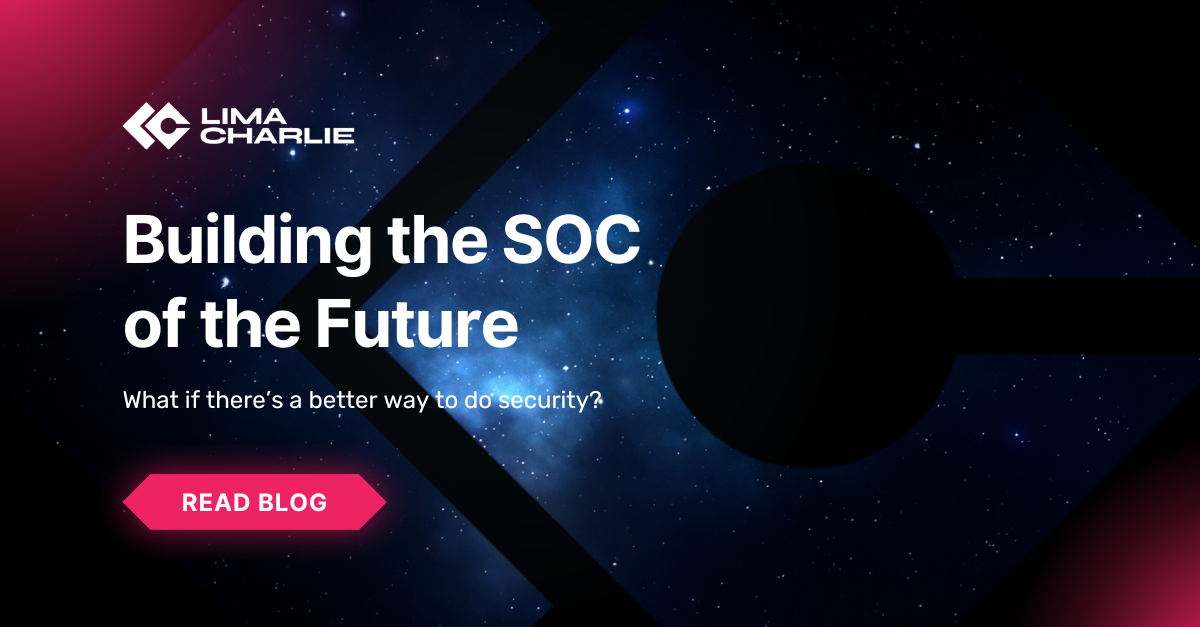July 25th, 2023
Building the SOC of the Future

Christopher Luft

The current model of the security operations center (SOC) is in need of change. In this post, we’ll discuss why that is the case, what changes are needed, and how a new approach—the SecOps Cloud Platform—can solve challenges for security teams and organizations.
Changing cybersecurity and economic landscapes
The world has changed—both in terms of cybersecurity as well as economics—and that has created new challenges for security teams:
Increasing complexity: Security teams must protect far more complex environments than before. Multiple OSes, a wide range of applications, users of all types and abilities, hybrid and remote workforces, mobile and IoT devices, mission-critical databases and SaaS apps, environments split between on-prem and cloud—and the list goes on. To put it simply: Things just aren’t that simple anymore.
Tool sprawl and stack fragmentation: IT complexity has spawned specialized solutions that address narrow cybersecurity problems. The result is tool sprawl and fragmentation in the cybersecurity infrastructure that teams use. Black box solutions and open-source tools must be stitched together in an attempt to minimize gaps in coverage. This approach is costly, difficult to maintain, and often results in integration problems. SIEM, orchestration, and visibility tools help bring some order to the chaos, but have limitations and are notoriously costly.
Vendor protectionism: The cybersecurity vendor market fosters a protectionist sales and technology culture. Proprietary technology leads to black box tools and a “trust us, you’re safe” mentality. Long-term contracts and cumbersome sales processes result in vendor lock-in. SOC teams must work with a security stack that is frustratingly opaque—while business decision-makers find themselves hamstrung by a lack of agility and high switching costs.
Economic uncertainty: The economy has always been subject to shifts and downturns, but the past several years have been especially challenging. The causes are manifold: COVID-19, the war in Ukraine, growing tension between the US and China, mass layoffs in the tech industry, and a climate crisis the effects of which are just starting to be felt in earnest. The resulting volatility and economic uncertainty mean that cybersecurity teams are under pressure to cut costs and “do more with less” like never before.
An evolving cybersecurity workforce: The cybersecurity skills gap is real. But cybersecurity has also matured dramatically as a discipline over the past decade. For many security teams, this has created a situation as paradoxical as it is frustrating. There aren’t enough skilled people to fill all of the open positions—but the overall level of skill and knowledge in most modern SOCs has increased. The result is an industry-wide feeling of overwhelm and exasperation: a sense among SOC teams that they could be doing more to improve organizational security…if only they had the resources they needed and weren’t exhausted from constantly putting out fires.
Tasked with the impossible
In effect, then, many SOC teams are now being asked to do the impossible.
They’re supposed to defend highly complex IT environments using a patchwork of tools that were never intended to work together.
They need to guarantee enterprise security and compliance but are forced to rely on opaque solutions that can’t be easily customized.
They need to coordinate everything with the help of expensive SIEM and orchestration tools while simultaneously being asked to control costs.
And they must do all that—24x7x365—with understaffed and overworked teams.
Clearly, this operating model is not sustainable. Many questions could be asked about the situation in modern SOCs. Only one is essential:
What if there’s a better way to do security?
Enter the SecOps Cloud Platform
The challenges facing security teams today may sound strangely familiar—and with good reason. They parallel, almost exactly, many of the problems enterprise IT was trying to solve in the early 2000s. The answer to those seemingly insoluble problems was, as we now know, the IT public cloud. LimaCharlie was founded on the premise that a similar transformation is needed in cybersecurity: the SecOps Cloud Platform.
The SecOps Cloud Platform delivers cybersecurity capabilities and infrastructure in a way that closely resembles the IT public cloud. Here are the core concepts:
Solutions are designed to interoperate in an un-opinionated way. The SecOps Cloud Platform is best seen as an environment, or a fabric, for doing cybersecurity. It is not a hodgepodge of disparate tools. There is no room for vendor protectionism and opacity.
Automation is built into the SecOps Cloud Platform. Teams can streamline workflows and respond to threats faster. Automation at scale across multi-tenant environments is considered to be a fundamental capability.
Openness and flexibility are foundational principles. Everything is API-first and well-documented. Security teams have complete visibility into and control over their security stack.
Teams have full control of their data. Security teams can import telemetry data from any source, route it to any destination, view everything in a unified data format, and access and query stored data at will.
Delivery is on-demand. Security teams can access the capabilities they need, when they need them. There aren’t any lengthy sales processes or contracts to sign. Self-service procurement and rapid deployment are the norm. Pricing is affordable and predictable. Scaling up or down is simple and easy.
The SecOps Cloud Platform isn’t just another solution. It is not even specific to one platform or vendor—just as the IT public cloud is much bigger than Azure or Microsoft.
Rather, the SecOps Cloud Platform represents a new paradigm for cybersecurity: one that addresses the current problems and pain points facing security teams. It is an approach that delivers the core capabilities needed to secure and monitor any organization—in a way that empowers security teams and helps them fully leverage their skills and expertise.
The LimaCharlie SecOps Cloud Platform
The LimaCharlie SecOps Cloud Platform is our vision of everything the SecOps Cloud Platform should be. It is a foundation upon which to build the SOC of the future—giving teams everything they need to solve their biggest problems and transform their operations, tooling, and infrastructure. Here are the most essential capabilities for security teams:
API-first access to an ecosystem of 100+ cybersecurity capabilities and integrations. Everything is delivered as a cloud-native primitive and is designed for interoperability.
Multi-tenant architecture. Teams can easily expand and manage deployments at scale.
A common data format for telemetry data. All security data is unified and viewable in a single hub.
Vendor neutrality. Fine-grained API permissions and webhooks allow teams to integrate the LimaCharlie SecOps Cloud Platform with outside solutions as needed.
Full control of telemetry data. Teams can ingest data from any source and export data to any destination. All telemetry data is stored free for one year.
A powerful Detection, Automation, and Response Engine. Teams can write their own complex detection logics or subscribe to open-source and curated rule sets, automate monitoring and security workflows, and enable wire-speed response actions on endpoints via our Agent.
On-demand access and transparent pricing. No contracts, capacity planning, price modeling, or negotiations. Procurement is self-service. Teams pay only for what they use and can spin up or down as needed.
Stepwise integration—not wholesale migration
If you say “cloud migration” to a business decision-maker, they will likely hear “complex, time-consuming, and expensive.” But the LimaCharlie SecOps Cloud Platform is designed from the ground up to enable simple, stepwise integration for security teams and enterprises.
All capabilities in the LimaCharlie SecOps Cloud Platform are available on-demand, delivered API-first, and built to scale. The underlying philosophy of our company is to empower teams and organizations to take full control of their cybersecurity posture. LimaCharlie makes it easy for enterprises to transition to a SecOps Cloud Platform model—progressively, rationally, safely, and efficiently.
The natural first step for many organizations will be shifting their telemetry data to the SecOps Cloud Platform. There are many potential benefits here, but the one most likely to capture the interest of organizational decision-makers is the ability to use the SecOps Cloud Platform to route data cost-effectively—rather than sending everything to high-cost SIEMs and data lakes. In this way, enterprises can achieve significant savings virtually overnight.
With telemetry data (and spending) under control, organizations can realize additional value by eliminating one-off vendors and replacing them with core SecOps Cloud Platform capabilities. This helps to reduce vendor sprawl and brings down costs even more. Because all LimaCharlie SecOps Cloud Platform capabilities are designed for interoperability, it also means that an organization’s security stack will be more effectively integrated than ever before.
Organizations are now in an excellent position to build a truly next-generation SOC. Costs are down. Infrastructure and tooling have been greatly simplified. Security teams are no longer weighed down by the task of maintaining and integrating dozens of disparate solutions. They are at long last able to unleash their full potential. The Detection, Automation, and Response Engine allows teams to perform historical threat hunting, implement advanced security disciplines like detection engineering, and respond to threats on endpoints in 100ms. At this point, enterprises and security teams may even begin to consider replacing their legacy EDR tool with a more powerful and cost-effective custom solution.
Beyond this, the future is an open road. The SecOps Cloud Platform is a journey, not a destination. The LimaCharlie SecOps Cloud Platform will continue to add capabilities and integrations in the coming years. But the real meaning of the SecOps Cloud Platform is that the SOC of the future will not be built by any one vendor or group of vendors—but by security teams themselves.
Learning More
For a deep dive into LimaCharlie’s vision of the SecOps Cloud Platform, and an introduction to the features and capabilities of the LimaCharlie SecOps Cloud Platform, watch our event:
An Invitation to Change: Introducing the SecOps Cloud Platform
To explore the LimaCharlie SecOps Cloud Platform, book a demo or try it for free on your own.